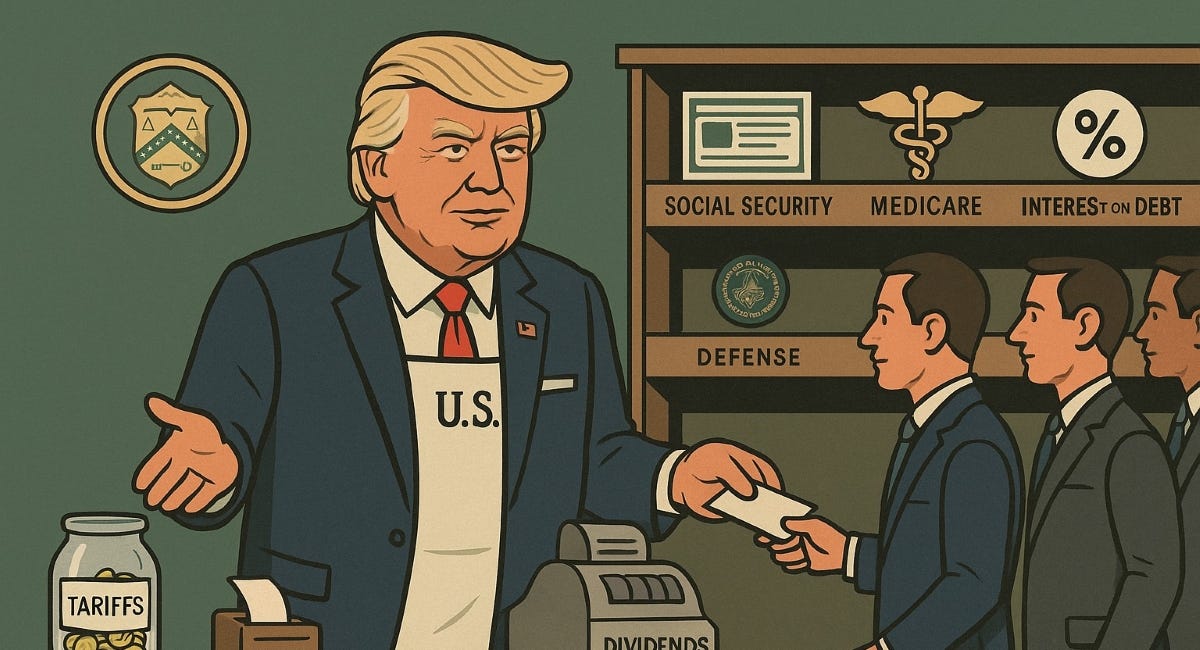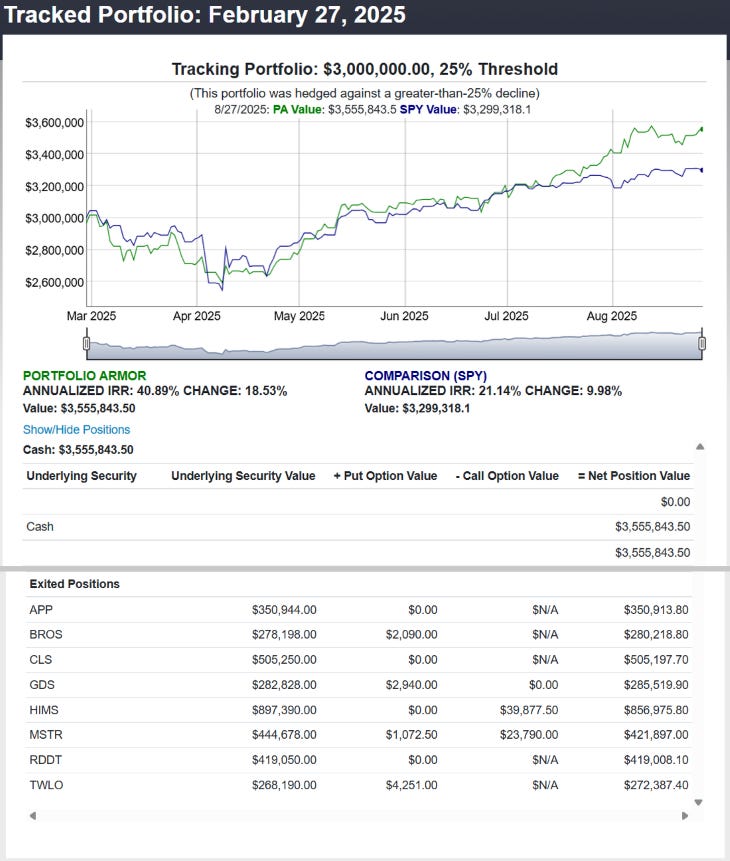After The Appeals Court
Can Trump's fiscal playbook still work?
Can the “Tariffs + Stakes” Playbook Still Work?
Earlier this week, we wrote about how Trump may have solved America's fiscal dilemma, in part by using tariffs.
How Trump May Have Solved America's Fiscal Dilemma
Note: Added a section to the end talking about the other side of the fiscal equation, reducing spending.
Now a federal appeals court has ruled against the Trump administration's tariffs. Let's break down what actually happened, what might happen next, and what options the Trump administration has from here. We'll also look at a way investors can manage the tariff uncertainty.
What changed (and what didn’t)
A federal appeals court held that the administration’s IEEPA-based global tariffs exceed presidential authority because IEEPA’s power to “regulate importation” doesn’t clearly include tariffs—a textbook major-questions problem. Crucially, the court kept the tariffs in place for now by staying its own ruling until October 14, giving DOJ time to go to the Supreme Court. In short: status quo through mid-October, at least. Federal Circuit Court+1
What happens at the Supreme Court?
The administration’s ask: an emergency stay that extends the pause beyond Oct. 14 while the Court decides whether to take the case and, if it does, through a merits ruling. That’s procedurally normal after an appellate stay with a dated sunset. Reuters
Merits odds: the appeals court framed IEEPA as not a tariff statute and leaned hard on major-questions; that posture makes an outright government win uncertain. Federal Circuit Court
The Algonquin/§232 lane—why it matters
When people say “use §232 instead,” they’re invoking Federal Energy Administration v. Algonquin (1976), where the Supreme Court upheld Section 232 as a valid delegation that lets a president “adjust imports” for national security—including with tariff-like license fees—if the statute’s process is followed (Commerce investigation, findings, and tight timing). Translation: §232 is court-tested tariff authority; IEEPA isn’t. Justia Law, Every CRS Report
If SCOTUS ultimately rules against the IEEPA tariffs
The administration still has options—just not a universal, one-click tariff:
Re-ground actions in clear tariff statutes
§232 (national security): targeted, product-specific duties/quotas after a Commerce probe. Slower and narrower than a global tax, but strong legally. FAS Project on Government Secrecy
§201 (safeguards): temporary global tariffs/quotas if the ITC finds serious injury—again, process-heavy but WTO-defensible. FAS Project on Government Secrecy, USITC
§301 (unfair practices): country/sector-specific tariffs after a USTR investigation (e.g., China tools already in use). FAS Project on Government Secrecy
Ask Congress for explicit “reciprocal tariff” authority
A narrowly drafted statute would cure the IEEPA gap the court flagged and avoid major-questions headwinds. (Hill staff are already circulating comparative authority memos across §232/§201/§301/§122.) Congress.govNon-tariff levers (less revenue, but leverage): embargoes/quotas via IEEPA are likelier to survive (IEEPA historically backs blocking and prohibitions), but they don’t generate receipts. Trade-remedy cases (AD/CVD) can also be accelerated where evidence supports them. Federal Circuit Court
Keep building the other legs of your thesis
Our original stack wasn’t “tariffs or bust.” Minority equity stakes (Intel template → defense primes) and IP monetization/Bayh-Dole enforcement don’t rely on IEEPA and can still spin off dividends/cash to Treasury.
Would a Supreme Court loss shock markets?
Directionally mixed, volatility likely.
On announcement in April, the tariff shock hit risk assets hard and pushed flows into havens. A clean SCOTUS loss (with no immediate replacement program) likely triggers relief in import-reliant retail/apparel/electronics and some give-back in protected domestics (steel/aluminum/autos). The deficit optics (tariff revenue disappears; potential refunds of previously collected duties) tug the other way for rates. Net: choppy around stay deadlines and the emergency-stay ruling. Reuters+2
The investor angle: navigating policy-driven whiplash
If you want upside without open-ended policy risk, consider the hedged-portfolio method. We offered a quick primer on it in a recent post.
Swinging For The Fences—Without Blowing Up
Note: This post is about the Portfolio Armor website’s hedged portfolio construction tool. The overlap with this Substack is that both draw from Portfolio Armor’s top names, but what the website offers is for investors who want to strictly limit their risk.
In brief: our system assembles a basket of names with positive expected returns, after you set a maximum drawdown you’re willing to tolerate (e.g., 8–20%). It then uses optimal puts or collars to strictly limit downside while leaving room for gains.
Why this fits the current moment: headlines around stays, Supreme Court timing, and tariff workarounds can gap markets in both directions. Pre-budgeted hedges let you stay in positions through those shocks with defined risk.
We just posted the final 6-month results for the latest batch of hedged portfolios launched before “Liberation Day", and the performance remains strong. The best-performing hedged portfolio nearly doubled the performance of the market over the same time frame.
You can see an interactive version of that chart here. As a reminder, paid subscribers to this Substack are eligible for a 20% discount on the Portfolio Armor web app, which includes the automated hedged portfolio construction tool. Reply to this post if you would like a coupon code for it.
What to watch next
Oct. 14 clock: appellate stay expiration; watch for a Supreme Court emergency stay that extends it. Reuters, Al Jazeera
Plan-B filings: any new §232 national-security investigations at Commerce; §201 petitions at ITC; §301 actions at USTR. FAS Project on Government Secrecy+2FAS Project on Government Secrecy+2
Refund mechanics: if tariffs are unwound, importers will fight about who gets what and how quickly—administratively messy, market-moving at the margin. AP News, PIIE






